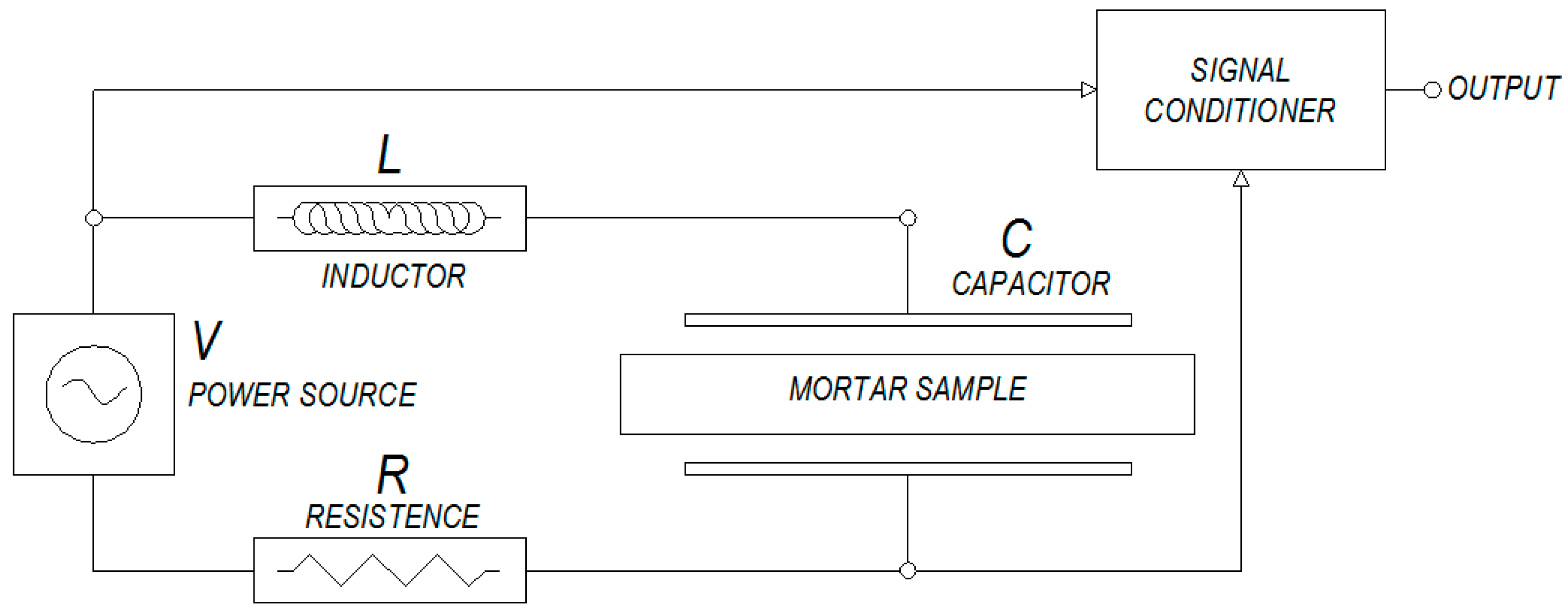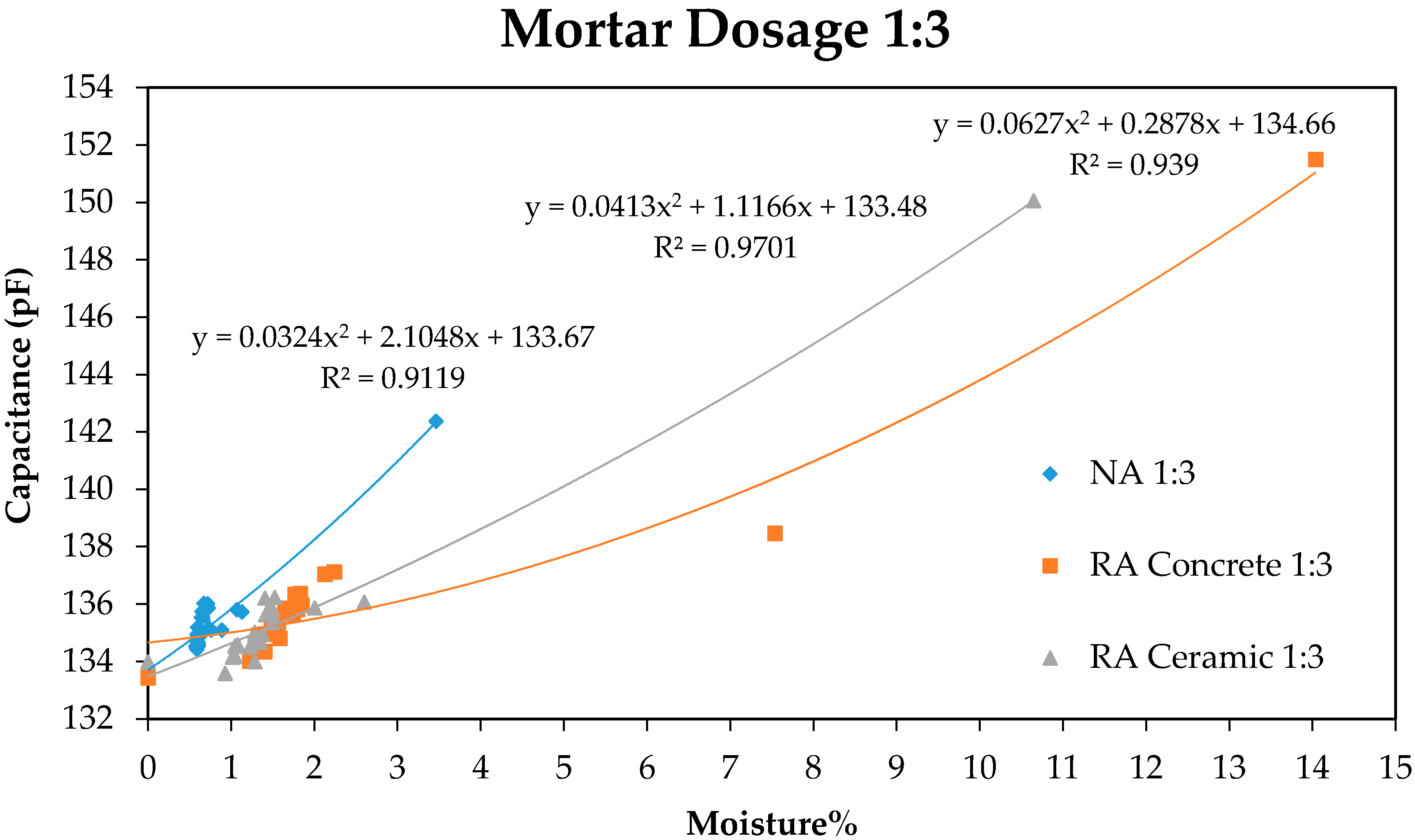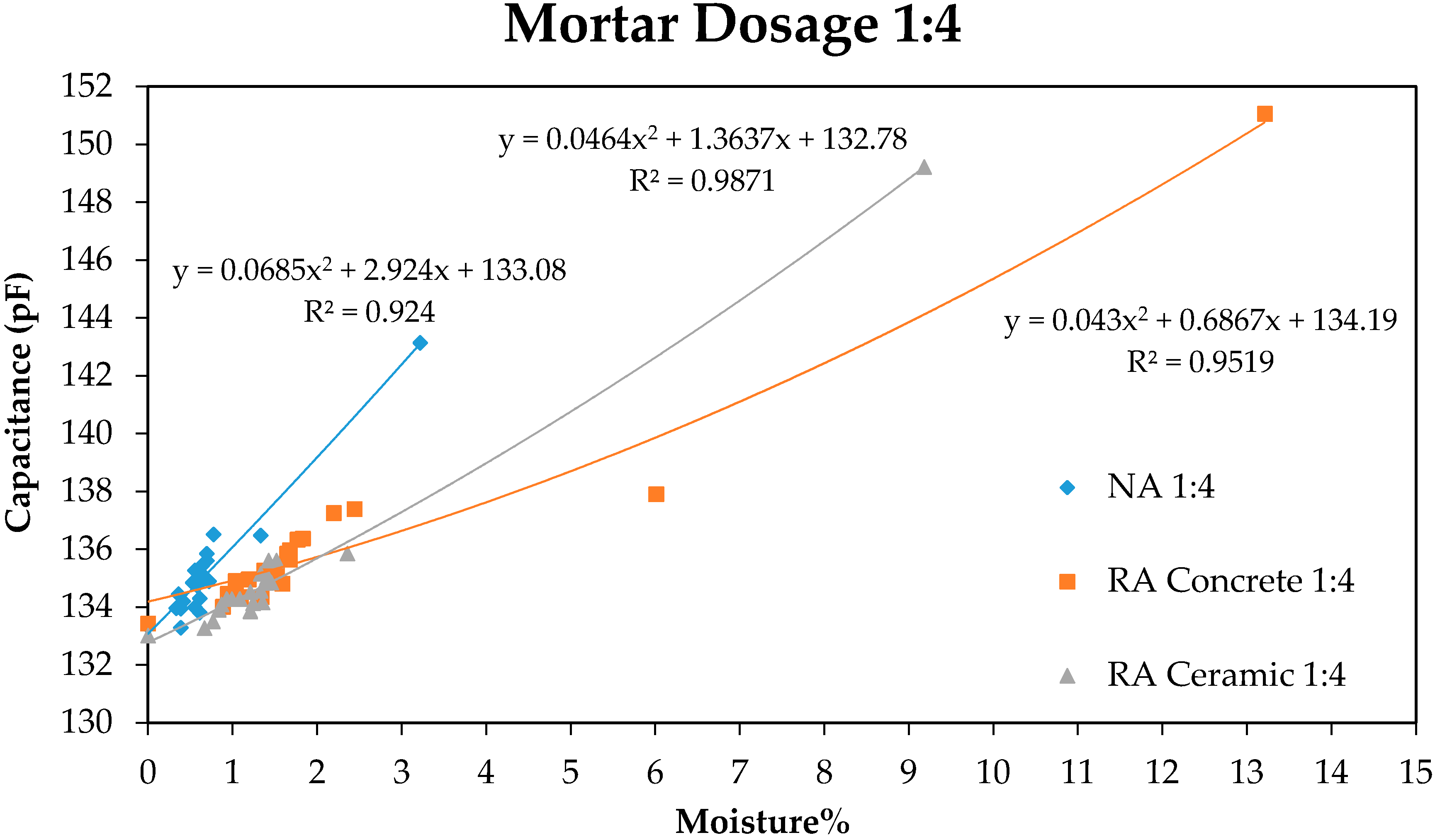New System of Shrinkage Measurement through Cement Mortars Drying
Abstract
:1. Introduction
2. Methodology
2.1. Fabrication of Mortar Specimens
2.2. Capacitive Sensor Design
2.3. Method of Moisture and Shrinkage Measure
3. Results and Discussion
3.1. Variation of Capacitance with Regard to the Moisture
3.2. Variation of Shrinkage with Regard to the Moisture
4. Conclusions
Acknowledgments
Author Contributions
Conflicts of Interest
References
- Spanish Minister of Public Works. Instrucción de Hormigón Estructural EHE-08; Spanish Structural Concrete Code); Publishing Centre: Madrid, Spain, 2008. [Google Scholar]
- Martín-Morales, M.; Zamorano, M.; Ruiz-Moyano, A.; Valverde-Espinosa, I. Characterization of recycled aggregates construction and demolition waste for concrete production following the Spanish Structural Concrete Code EHE-08. Constr. Build. Mater. 2011, 25, 742–748. [Google Scholar] [CrossRef]
- Barbudo, A.; Agrela, F.; Ayuso, J.; Jiménez, J.R.; Poon, C.S. Statistical analysis of recycled aggregates derived from different sources for sub-base applications. Constr. Build. Mater. 2012, 28, 129–138. [Google Scholar] [CrossRef]
- Braga, M.; De Brito, J.; Veiga, R. Incorporation of fine concrete aggregates in mortars. Constr. Build. Mater. 2012, 36, 960–968. [Google Scholar] [CrossRef]
- Villoria, P.; del Río, M.; Porras, C.; de San Antonio, A. European legislation and implementation measures in the management of construction and demolition waste. Open Constr. Build. Technol. J. 2011, 5 (Suppl. 2-M6), 156–161. [Google Scholar] [CrossRef]
- Vegas, I.; Azkarate, I.; Juarrero, A.; Frías, M. Design and performance of masonry mortars made with recycled concrete aggregates. Mater. Constr. 2009, 59, 5–18. [Google Scholar] [CrossRef]
- Jímenez, J.R.; Ayuso, J.; López, M.; Fernández, J.M.; de Brito, J. Use of fine recycled aggregates from ceramic waste in masonry mortar manufacturing. Constr. Build. Mater. 2013, 40, 679–690. [Google Scholar] [CrossRef]
- Corinaldesi, V.; Moriconi, G. Behaviour of cementitious mortars containing different kinds of recycled aggregate. Constr. Build. Mater. 2009, 23, 289–294. [Google Scholar] [CrossRef]
- Saiz, P.; González, M.; Fernández, F.; Rodríguez, A. Comparative study of three types of fine aggregates from construction and demolition waste (CDW), and their use in masonry mortar fabrication. J. Clean. Prod. 2016, 118, 162–169. [Google Scholar] [CrossRef]
- Medina, C.; Sánchez de Rojas, M.; Frías, M. Reuse of sanitary ceramic wastes as coarse aggregate in eco-efficient concretes. Cem. Concr. Compos. 2012, 34, 48–54. [Google Scholar] [CrossRef]
- Sánchez, M.; Alaejos, P. Study on the influence of attached mortar content on the properties of recycled concrete aggregate. Constr. Build. Mater. 2009, 23, 872–877. [Google Scholar]
- Duan, Z.H.; Poon, C.S. Properties of recycled aggregate concrete made with recycled aggregates with different amounts of old adhered mortars. Mater. Des. 2014, 58, 19–29. [Google Scholar] [CrossRef]
- Kou, S.C.; Poon, C.S. Effect of quality of parent concrete on the mechanical properties of high concrete performance recycled aggregate concrete. J. Chin. Ceram. Soc. 2012, 40, 1–6. [Google Scholar]
- Gonzalez-Corominas, A.; Etxeberria, M. Effects of using recycled concrete aggregates on the shrinkage of high performance concrete. Constr. Build. Mater. 2016, 115, 32–41. [Google Scholar] [CrossRef]
- Bendimerad, A.Z.; Roziere, E.; Loukili, A. Plastic shrinkage and cracking risk of recycled aggregates concrete. Constr. Build. Mater. 2016, 121, 733–745. [Google Scholar] [CrossRef]
- Seara-Paz, S.; González, B.; Martínez, F.; González, I. Time-dependent behaviour of structural concrete made with recycled coarse aggregates. Creep and shrinkage. Constr. Build. Mater. 2016, 122, 95–109. [Google Scholar] [CrossRef]
- García-Messeguer, A.; Morán Cabré, F.; Arroyo Portero, J.C. Jiménez Montoya Hormigón Armado, 15th ed.; Gustavo Gil, S.L., Ed.; Editorial Gustavo Gili: Barcelona, Spain, 2011. [Google Scholar]
- Papez, J.; Kic, P. Wood moisture of rural timber construction. Agron. Res. 2013, 11, 505–512. [Google Scholar]
- Noreña, L.; Cortés, D. Characterization and calibration of low cost humidity sensor to optimize their performance in a WSN network in indoor settings. Actas Ing. 2015, 1, 169–173. [Google Scholar]
- Kim, G.; Kim, J.; Kurtis, K.E.; Jacobs, L.J. Drying shrinkage in concrete assessed by nonlinear ultrasound. Cem. Concr. Res. 2017, 92, 16–20. [Google Scholar] [CrossRef]
- Islam, T.; Nimal, A.T.; Mittal, U.; Sharma, M.U. A micro interdigitated thin film metal oxide capacitive sensor for measuring moisture in the range of 175–926 ppm. Sens. Actuators B Chem. 2015, 221, 357–364. [Google Scholar] [CrossRef]
- Morón, C.; García-Fuentevilla, L.; García, A.; Morón, A. Measurement of moisture Wood for application in restoration of old buildings. Sensors 2016, 16, 697. [Google Scholar] [CrossRef] [PubMed]
- Rahat, M.; Hassan, Z.; Islam, T. A sensitive and highly linear capacitive thin film sensor for trace moisture measurement in gases. Sens. Actuators B Chem. 2016, 228, 658–664. [Google Scholar]
- Hu, N.; Karube, Y.; Yan, C.; Masuda, Z.; Fukunaga, H. Tunnelling effect in a polymer/carbon nanotube nanocomposite strain sensor. Acta Mater. 2008, 56, 2929–2936. [Google Scholar] [CrossRef] [Green Version]
- Tsamis, E.D.; Avaritsiotis, J.N. Design of planar capacitive type sensor for “water content” monitoring in a production line. Sens. Actuators A Phys. 2005, 118, 202–211. [Google Scholar] [CrossRef]
- Spanish Standard UNE-EN 196-1. Methods of Testing Cement. Part 1: Determination of Strength; AENOR: Madrid, Spain, 2005. [Google Scholar]
- UNE-EN 1015-3:2000. Methods of Test for Mortar for Masonry. Part 3: Determination of Consistence of Fresh Mortar (by Flow Table); AENOR: Madrid, Spain, 2007. [Google Scholar]
- UNE 80-112-89. Experimental: Métodos de Ensayo de Cementos: Ensayos Físicos: Determinación de la Retracción de Secado y del Hinchamiento en Agua; AENOR: Madrid, Spain, 1989. [Google Scholar]






| Type | Cement (g) | Aggregate (g) | Water (g) | Additive (%) | Proportion | |
|---|---|---|---|---|---|---|
| (c/a) 2 | (w/c) 3 | |||||
| M-NA-X | 450 | 1350 | 261 | - | 1:3 | 0.58 |
| M-Con RA-X | 450 | 1350 | 306 | 1 1 | 1:3 | 0.68 |
| M-Cer RA-X | 450 | 1350 | 306 | 1 1 | 1:3 | 0.68 |
| M-NA-Y | 337.5 | 1350 | 202.5 | - | 1:4 | 0.60 |
| M-Con RA-Y | 337.5 | 1350 | 300.4 | 1 1 | 1:4 | 0.89 |
| M-Cer RA-Y | 337.5 | 1350 | 300.4 | 1 1 | 1:4 | 0.89 |
© 2017 by the authors. Licensee MDPI, Basel, Switzerland. This article is an open access article distributed under the terms and conditions of the Creative Commons Attribution (CC BY) license ( http://creativecommons.org/licenses/by/4.0/).
Share and Cite
Morón, C.; Saiz, P.; Ferrández, D.; García-Fuentevilla, L. New System of Shrinkage Measurement through Cement Mortars Drying. Sensors 2017, 17, 522. https://doi.org/10.3390/s17030522
Morón C, Saiz P, Ferrández D, García-Fuentevilla L. New System of Shrinkage Measurement through Cement Mortars Drying. Sensors. 2017; 17(3):522. https://doi.org/10.3390/s17030522
Chicago/Turabian StyleMorón, Carlos, Pablo Saiz, Daniel Ferrández, and Luisa García-Fuentevilla. 2017. "New System of Shrinkage Measurement through Cement Mortars Drying" Sensors 17, no. 3: 522. https://doi.org/10.3390/s17030522






